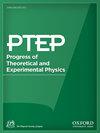奇异海对 JP = 1/2+, 3/2+ 重子的电荷半径和四极矩的重要性
IF 8.3
4区 物理与天体物理
Q1 Physics and Astronomy
引用次数: 0
摘要
我们采用了一个与详细平衡原理相结合的统计框架来研究 JP=$\frac{1}{2}^+$ 八元和 JP=$\frac{3}{2}^+$ 十元重子的低能特性,即电荷半径和四极矩。统计模型依赖于重子可以用夸克-胶子 Fock 状态展开的假设。我们系统地应用算子形式主义和统计方法来研究重子的电荷半径和四极矩。根据自旋、味道和颜色空间中所有可能的 Fock 状态的概率,研究了夸克和胶子海的重要性。探讨了组成夸克和海(标量海、矢量海和张量海)的各自贡献。由于奇异内容和非奇异内容之间存在巨大的质量差异,我们还研究了SU(3)的破缺效应。根据实验证据,奇异$q\bar{q}$对在海中的考虑程度受到强子质量和胶子自由能的制约。我们重点研究了奇异和非奇异海子($g, \langle u\bar{u}\rangle$, $\langle d\bar{d}\rangle$ 和 $\langle s\bar{s}\rangle$ )在各自的强子中对其电荷半径和四极矩的可适应性的单独贡献。本研究与各种理论方法和一些已知的实验观测结果进行了比较。所获得的结果可能会为即将到来的实验发现提供有价值的信息。本文章由计算机程序翻译,如有差异,请以英文原文为准。
Importance of strange sea to the charge radii and quadrupole moment of JP = 1/2+, 3/2+ baryons
A statistical framework in conjugation with the principle of detailed balance is employed to examine the low-energy properties i.e. charge radii and quadrupole moment of JP=$\frac{1}{2}^+$ octet and JP=$\frac{3}{2}^+$ decuplet baryons. The statistical model relies on the assumption that the baryons can be expanded in terms of quark-gluon Fock states. We systematically apply operator formalism along with the statistical approach to study the charge radii and quadrupole moment of baryons. Based on the probabilities of all possible Fock states in spin, flavor and color space, the importance of sea with quarks and gluons is studied. The individual contribution of the constituent quarks and sea (scalar, vector and tensor sea) is explored. Due to large mass difference between strange and non-strange content, the SU(3) breaking effect are also investigated. The extent to which strange $q\bar{q}$ pairs is considered in sea is constrained by the mass of hadrons and the free energy of gluons, in accordance with experimental evidence. We focus on the individual contribution of strange and non-strange sea ($g, \langle u\bar{u}\rangle$, $\langle d\bar{d}\rangle$ and $\langle s\bar{s}\rangle$) accomodability in the respective hadrons for their charge radii and quadrupole moment. The present work has been compared with various theoretical approaches and some known experimental observations. The obtained results may give valuable information for upcoming experimental findings.
求助全文
通过发布文献求助,成功后即可免费获取论文全文。
去求助
来源期刊

Progress of Theoretical and Experimental Physics
PHYSICS, MULTIDISCIPLINARY-PHYSICS, PARTICLES & FIELDS
CiteScore
12.00
自引率
5.70%
发文量
148
审稿时长
17 weeks
期刊介绍:
Progress of Theoretical and Experimental Physics (PTEP) is an international journal that publishes articles on theoretical and experimental physics. PTEP is a fully open access, online-only journal published by the Physical Society of Japan.
PTEP is the successor to Progress of Theoretical Physics (PTP), which terminated in December 2012 and merged into PTEP in January 2013.
PTP was founded in 1946 by Hideki Yukawa, the first Japanese Nobel Laureate. PTEP, the successor journal to PTP, has a broader scope than that of PTP covering both theoretical and experimental physics.
PTEP mainly covers areas including particles and fields, nuclear physics, astrophysics and cosmology, beam physics and instrumentation, and general and mathematical physics.
 求助内容:
求助内容: 应助结果提醒方式:
应助结果提醒方式:


